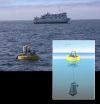(Press-News.org) Researchers from the University of Hawai'i - M?noa (UHM) and colleagues found that microbial communities in different regions of the Pacific Ocean displayed strikingly similar daily rhythms in their metabolism despite inhabiting extremely different habitats - the nutrient-rich waters off California and the nutrient-poor waters north of Hawai'i. Furthermore, in each location, the dominant photoautotrophs - light-loving bacteria that need solar energy to help them photosynthesize food from inorganic substances - appear to initiate a cascade effect wherein the other major groups of microbes perform their metabolic activities in a coordinated and predictable way.
As expected, different photoautotrophs dominated the coastal versus open ocean. In contrast, many other heterotrophic bacterial groups were common to both habitats. For the study published this week in the Proceedings of the National Academy of Sciences, the researchers monitored when, throughout the day, these microbes turn on and turn off genes that regulate key metabolic processes (referred to as "transcriptional patterns"). The bacterial groups common to both ecosystems displayed the same transcriptional patterns and daily rhythms - as if each group is performing its prescribed role at a precise time each and every day, even though these communities are separated by thousands of miles.
"Our work suggests that these microbial communities broadly behave in a similar manner across entire ocean basins and that specific biological interactions between these groups are widespread in nature," said Frank Aylward, post-doctoral scholar at the Center for Microbial Oceanography: Research and Education (C-MORE) at UHM and lead author of the study.
The investigation used a robotic sampler, the Environmental Sample Processor (ESP), recently developed by co-author Chris Scholin and his colleagues at the Monterey Bay Aquarium Research Institute (MBARI). Riding the same ocean currents as the microbes it follows, the ESP is uniquely equipped to harvest those microbes every few hours, so that researchers can measure exactly when different genes are turned on or off for many different species simultaneously. Using modern "next generation" genomic technologies Aylward and colleagues were then able to evaluate the daily gene expression cycles in microbial communities in the wild.
Generally microbes from coastal (California coast) and open-ocean (North Pacific Subtropical Gyre) waters have been thought of as completely distinct communities that are shaped by very different environmental conditions. Waters near Hawaii experience high levels of sunlight and warm temperatures year round, for example, while coastal California waters are colder and undergo marked seasonal transitions.
"Surprisingly, however," said Aylward, "our work shows that these extremely different ecosystems exhibit very similar diel cycles, driven largely by sunlight and interspecies microbial interactions. This suggests that different microbial communities across the Pacific Ocean, and likely waters across the entire planet, behave in much more orderly ways than has previously been supposed.
"There is a lot more order out there in the ocean than we had previously thought, on vast spatial scales," remarked Edward DeLong, UHM professor of oceanography and senior author of the paper. "Each day, as sunlight hits the water, a very highly orchestrated cascade of species-specific activities takes place, with each microbe chiming in at a very precise time, each and every day. This sort of predictable pattern may allow us to better predict the specific timing of matter and energy transformations that are catalyzed by microbes on a daily basis."
Because of the large volumes of carbon dioxide sequestered by microbes in the oceans, this work has important implications for understanding the factors that shape large-scale carbon cycling in the biosphere. Because interactions between microbial groups appeared to be conserved between environments, this work also has implications for understanding fundamental patterns of how the activities of microscopic life give rise to ecosystem-level phenomena at much larger scales.
Along with their collaborators in the newly established, UH-based initiative called the Simons Collaboration on Ocean Processes and Ecology (SCOPE), the team hopes to achieve finer resolution sampling in space and time using improved robotic sampling devices currently being designed at MBARI. This will help identify more precisely how microbes are interacting with each other in seawater and how they respond to environmental stimulus.
INFORMATION:
Frank O. Aylward, John M. Eppley, Jason M. Smith, Francisco P. Chavez, Christopher A. Scholin, and Edward F. DeLong (2015). Microbial community transcriptional networks are conserved in three domains at ocean basin scales, Proceedings of the National Academy of Sciences, doi:10.1073/pnas.1502883112
http://www.pnas.org/content/early/2015/03/05/1502883112.abstract
Related story:
http://www.hawaii.edu/news/2014/07/10/the-oceans-most-abundant-organisms-have-clear-daily-cycles/
The studies below will be presented at the American College of Cardiology's 64th Annual Scientific Session on Sunday, March 15.
1. Survey Suggests Cardiologists May Not Be Prepared to Counsel Patients on Heart Healthy Diets
Even though most doctors believe diet is important in preventing and managing cardiovascular disease, there are major gaps in their knowledge and, in turn, efforts to educate patients about heart healthy diets may be falling short, according to a recent survey of 236 cardiologists and internal medicine physicians and trainees at a large tertiary ...
Patients who received the new drug Bendavia before undergoing angioplasty or receiving a stent to clear blocked arteries after a heart attack showed no significant reduction in scarring as compared to patients given a placebo, according to a study presented at the American College of Cardiology's 64th Annual Scientific Session.
The study is the first randomized, controlled trial of Bendavia, a drug designed to reduce the extent of tissue damage in the heart through a new approach that targets mitochondria in the cells. Although patients receiving the drug showed a 10 ...
SAN DIEGO (March 15, 2015) -- A novel therapy that would allow doctors to turn the body's blood-clotting ability off and on in a more controlled way was about as effective as established anticoagulants in patients undergoing angioplasty but was associated with higher rates of moderate to severe bleeding, according to an analysis of data from a terminated Phase III trial presented at the American College of Cardiology's 64th Annual Scientific Session. The study was officially halted in August due to an excess of severe allergic reactions, so authors caution that the data ...
SAN DIEGO (March 15, 2015) -- Use of computed tomography coronary angiography, which provides 3-D images of the heart, coupled with standard care allows doctors to more accurately diagnose coronary artery disease in patients presenting with chest pain, therefore, leading to more appropriate follow-up testing and treatments, according to research presented at the American College of Cardiology's 64th Annual Scientific Session. Data also showed a trend toward a lower incidence of heart attacks among the group receiving the tests, known as CT scans, compared to usual care. ...
SAN DIEGO (March 15, 2015) -- Patients taking evolocumab--an investigational therapy previously shown to dramatically lower "bad" cholesterol--were half as likely to die, suffer a heart attack or stroke, be hospitalized or need a procedure to open blocked arteries compared with those who received standard care, according to research presented at the American College of Cardiology's 64th Annual Scientific Session in San Diego.
In this open-label study, the rate of cardiovascular events was 2.18 percent after one year in the standard of care group, most of whom were on ...
SAN DIEGO (March 15, 2015) -- The SAPIEN 3 heart valve demonstrated lower death, stroke and paravalvular leak rates than earlier generation devices in patients at high risk for surgery and showed encouraging results in intermediate-risk patients, according to research presented at the American College of Cardiology's 64th Annual Scientific Session.
Transcatheter aortic valve replacement, known as TAVR, is approved for patients with severe aortic stenosis--narrowing of the valve in the heart's main artery--whose health profile makes them ineligible or high-risk candidates ...
SAN DIEGO (March 15, 2015) -- An investigational device that deflects debris away from the brain during transcatheter aortic valve replacement seems to improve in-hospital safety outcomes and cognitive scores at discharge, according to preliminary findings from a small randomized study presented at the American College of Cardiology's 64th Annual Scientific Session.
The valve replacement procedure, known as TAVR, dislodges minute particles from the clogged valve, freeing them to float through the bloodstream. Much of this debris travels "downstream" from the heart, but ...
SAN DIEGO (March 15, 2015) -- Five-year data suggest that the SAPIEN transcatheter heart valve is a feasible option for patients with severe aortic stenosis deemed to be at high risk for open-heart surgery, though valve leakage was more common with the first-generation valve evaluated in this study than with surgery, according to research from PARTNER I presented at the American College of Cardiology's 64th Annual Scientific Session.
When the blockage of an aortic valve becomes severe, replacement is the only real treatment choice, but many elderly and frail people are ...
SAN DIEGO (March 15, 2015) -- Two-year data show a continued survival advantage for self-expanding transcatheter aortic valve replacement (TAVR) over standard surgery in high-risk patients with severe aortic stenosis, according to research presented at the American College of Cardiology's 64th Annual Scientific Session.
Aortic stenosis--a problem that occurs when the valve in the heart's main artery doesn't open fully--forces the heart to work harder to pump blood and is life-threatening over time. Valve replacement is common when this condition becomes severe, but the ...
SAN DIEGO (March 15, 2015) --The commercial track record with transcatheter mitral valve repair, approved for patients at high risk for surgery, compares favorably with pre-approval reports, according to findings from a U.S. registry presented at the American College of Cardiology's 64th Annual Scientific Session.
Healthy valves function as one-way gates that keep blood moving forward through the heart. Severely damaged mitral valves don't close properly, allowing blood to leak backward. If the valve isn't repaired or replaced, the condition can cause serious health ...

